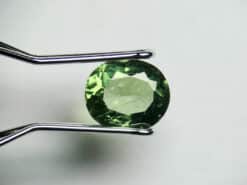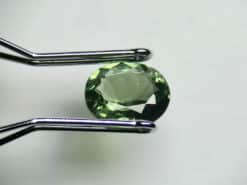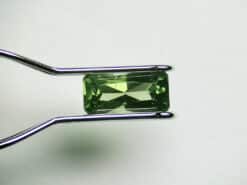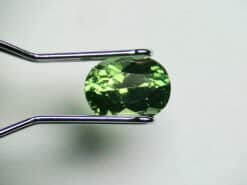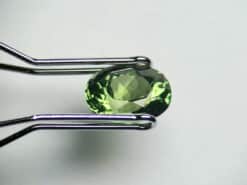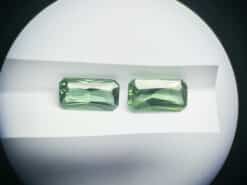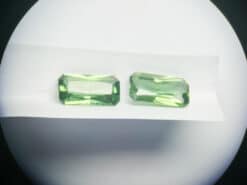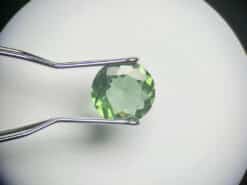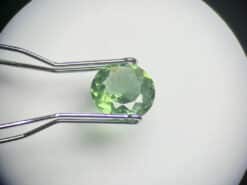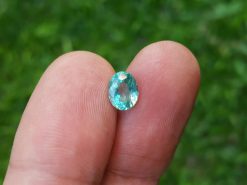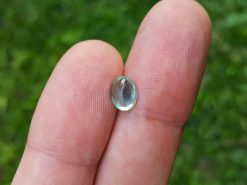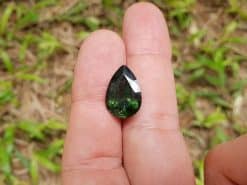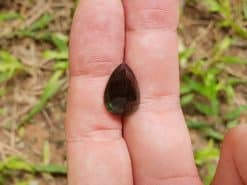Apatite
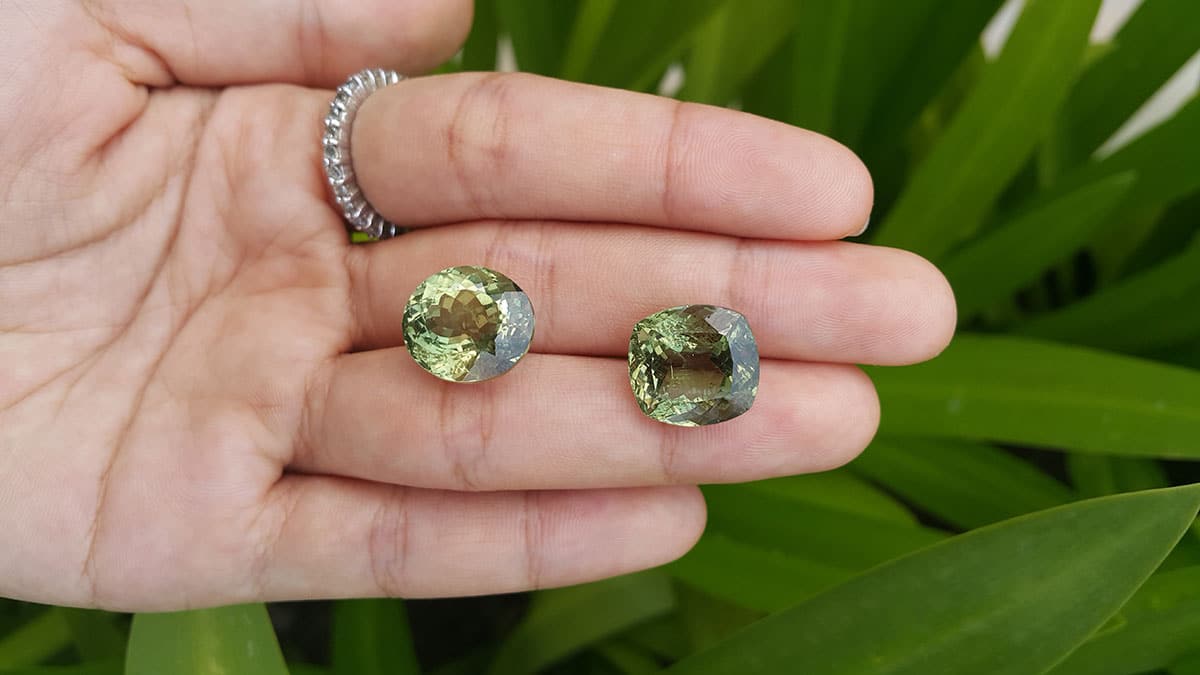
Green and blue apatite meanings and crystal properties. A generic name for hexagonal phosphates of varying composition.
Buy natural apatite side in our shop
A generic name for hexagonal phosphates of varying composition, Ca5 (PO4) 3 (OH, Cl, F). Three species named according to the prevalent anion:
Chlorapatite: Ca5 (PO4) 3 Cl
Fluorapatite: Ca5 (PO4) 3F
Hydroxyapatite: Ca5 (PO4) 3 (OH)
Two monoclinic variants
Two monoclinic variants are polytypes. All have isolated PO4 tetrahedra, with coordinating Ca2+ ions. The carbonate may replace a PO4 tetrahedron with a CO3OH or CO3F group.
Also, apatite may vary in appearance and color. Its chemical composition was determined at the end of the 19th century. Besides that, the German mineralogist Abraham Gottlob Werner gave it in 1786 this name, which is inspired by the Greek “apatan”, meaning “to deceive.”
Isostructural minerals
It serves as a leader for a group of isostructural minerals of general formula: A5 (XO4) 3Zq. In which calcium is replaced by strontium, cerium, manganese, yttrium, lead, and phosphorus is replaced by arsenic, vanadium, sulfur, silicon… (fluorellestadite…)
They are minerals of hexagonal or pseudo hexagonal-monoclinic structure, containing arsenates, phosphates, and vanadates, divided into two subgroups of apatite and pyromorphite.
A secondary mineral, common in magmatic rocks. Their concentration is not sufficient for industrial exploitation. Phosphorus contained in the iron ores actually passes completely into the metal phase: its elimination in the ripening phase of the iron ore steel is expensive.
Hydrothermal apatites
Hydrothermal crystals are less common. Pegmatitic or metamorphic specimens are minerals of great economic importance for their content of rare elements rather than for their phosphorus content.
Sedimentary apatites
Sedimentary gemstones have a chemical or organic origin. The raw material for the phosphorus industry is phosphorite, a phosphorous sedimentary rock whose main component is carbonato-fluorapatite. The inorganic part of the vertebrate skeletons is essentially carbonato-hydroxyapatite, and these skeletons form phosphate sediments.
Calcium phosphate is soluble in acidic environment, but much less so in an alkaline environment (sea). The change in pH when a river flows into the sea produces phosphate precipitation, which contributes to the turbid waters of estuaries.
Blue apatite meaning and crystal properties
The following section is pseudo scientific and based on cultural beliefs.
A stone of manifestation attuned to the future, activating psychic abilities and allowing expansion of knowledge. The stone will stimulate the intellect and bring ideas from the mind down into the earth realm through realizations.
This crystal allows for a deeper dive and reflection into one’s self, seeking self-insight and inner clarity. The gemstone will keep you on a search for freedom as it keeps you attuned to always planning what’s next in your life.
Green crystals stimulate the flow of energy on the physical plane and can be used as abundance stones for spiritual and financial manifestation, as well as connecting with the electromagnetic field of the planet. They allow one to replenish energy for the physical heart and to channel healing energies back to the Earth.
Geological Formation & Localities
Apatite typically crystallizes in igneous rocks, often forming small, transparent to opaque grains. It can also occur in metamorphic environments, where heat and pressure transform the original rock composition. Major deposits have been found in countries with significant geological diversity and volcanic activity. While most of these deposits yield industrial-grade material, certain localities are known for producing high-quality crystal specimens cherished by collectors.
Color Range & Care
Though green and blue varieties are among the most popular, apatite can exhibit numerous other hues including yellow, brown, and colorless forms. This versatility in color is influenced by trace elements or natural irradiation within the crystal structure. Because its hardness is around 5 on the Mohs scale, apatite should be handled with some care to avoid scratches. Warm water, mild soap, and a soft brush are recommended for cleaning. Avoid using harsh chemicals or exposing the stone to extreme temperature changes.
Historical Significance
In addition to its name origin from the Greek word meaning “to deceive,” apatite has long fascinated geologists and mineral enthusiasts. Though it was primarily recognized for its industrial uses, such as fertilizer and other phosphate-based products, it gradually gained attention among gemstone collectors for its lively colors and unique luster.
Metaphysical Perspectives
Beyond its industrial value, some cultures regard apatite as a crystal that helps balance one’s mental, emotional, and spiritual states. Many believe it inspires clarity of thought and fosters a sense of personal growth. Whether used as a focal point for meditation or simply admired for its vivid appearance, this mineral continues to captivate those who are drawn to its energetic properties and rich cultural lore.
FAQ
What is the use of apatite?
The primary use of this stone is in the manufacture of fertilizer. It is a source of phosphorus. It is occasionally used as a gemstone. Green and blue varieties, in finely divided form, are pigments with excellent covering power.
What is apatite gemstone?
A mineral group as the generic term for many phosphates, but gem-quality is a special stone found in a beautiful variety of colors. Various colors are often due to the presence of rare earth elements or natural irradiation.
What is apatite made of?
It is calcium phosphate combined with fluorine, chlorine, or hydroxyl. These three minerals are usually found in every specimen but some specimens have been known to have 100% of one or the other. It is often hard to spot the difference between the three minerals in hand samples of this stone.
What are the healing properties of apatite?
The crystal expands knowledge and truth and eases sorrow, apathy, and anger. Physically, the stone aids in the absorption of calcium, helping cartilage, bones, and teeth; healing bones and encouraging the formation of new cells. It improves arthritis and joint problems.
Is apatite rare?
While the stone is a common mineral, gem-quality is quite rare. The crystal is known by gemstone experts especially for two colors: the Paraiba-like blue-green, and the leek-green color that once earned the gem name “asparagus stone”.
How strong is green apatite?
The gem has a relatively consistent hardness and serves as the index mineral for a hardness of five in the Mohs hardness scale.
What is blue apatite good for?
Blue color encourages the formation of new cells and aids in the absorption of calcium. It helps heal bones and teeth, repairs cartilage, and is useful in the treatments for rickets, joint problems, arthritis, and motor skills. Blue stone may be used to soothe headaches and help with vertigo or dizziness.
Is blue apatite toxic?
You may have read that the stone is toxic because of its content. Hydroxyapatite is actually an essential component of our bones and teeth. And similarly as this gem, a small quantity is not toxic at all. Obviously, it’s better not to eat large amounts of stone powder, otherwise it could be dangerous. But nobody ever did that.
Natural apatite for sale in our gem shop
We make custom made apatite jewelry as engagement rings, necklaces, stud earrings, bracelets, pendants… Please contact us for a quote.

